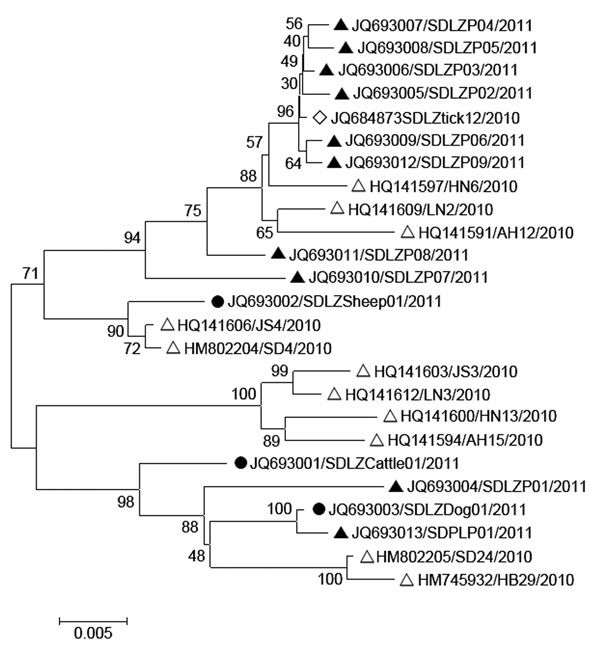Volume 19, Number 5—May 2013
Research
Severe Fever with Thrombocytopenia Syndrome Virus among Domesticated Animals, China
Figure 6

Figure 6. . . Phylogenetic analysis of severe fever with thrombocytopenia syndrome virus (SFTSV) isolates from domesticated animals. The evolutionary relationship of small segments of SFTSV isolated from domesticated animals, SFTS patients and ticks was calculated by using the neighbor-joining method with MEGA 5 (8). Sequences are labeled with the order of GenBank accession number/name of viral strain/year of isolation. Black circles indicate the original sequences of SFTSV strains obtained from domesticated animals in this study; black triangles indicated the original sequences of SFTSV strains obtained from SFTS patients in 2011 in this study; blank triangles indicate the previously published sequences of SFTSV strains obtained from 11 SFTS patients in 2010 (1); and open diamonds indicate the previously published sequences of SFTSV strains obtained from H. longicornis ticks in 2010 (3).
References
- Yu XJ, Liang MF, Zhang SY, Liu Y, Li JD, Sun YL, Fever with thrombocytopenia associated with a novel bunyavirus in China. N Engl J Med. 2011;364:1523–32 and. DOIPubMedGoogle Scholar
- Gai Z, Liang M, Ying Z, Zhang S, Jin C, Wang S, Person to person transmission of severe fever with thrombocytopenia syndrome bunyavirus through blood contact. Clin Infect Dis. 2012;54:249–52 and. DOIPubMedGoogle Scholar
- Jiang XL, Wang XJ, Li JD, Ding SJ, Zhang QF, Qu J, Isolation, identification and characterization of SFTS bunyavirus from ticks collected on the surface of domestic animals [in Chinese]. Bing Du Xue Bao. 2012;28:252–7.
- Zhao L, Zhai S, Wen H, Cui F, Chi Y, Wang L, Severe fever with thrombocytopenia syndrome virus, Shandong Province, China. Emerg Infect Dis. 2012:18:963–95. PMID:22608264 .DOIGoogle Scholar
- Zhang WS, Zeng XY, Zhou MH, Jiao YJ, Wen T, Guo XL, Seroepidemiology of severe fever with thrombocytopeia syndrome bunyavirus in Jiansu Province [in Chinese]. Dis Surveill. 2011;26:676–8.
- Jiao Y, Zeng X, Guo X, Qi X, Zhang X, Shi Z, Preparation and evaluation of recombinant severe fever with thrombocytopenia syndrome virus nucleocapsid protein for detection of total antibodies in human and animal sera by double-antigen sandwich enzyme-linked immunosorbent assay. J Clin Microbiol. 2012;50:372–7 and. DOIPubMedGoogle Scholar
- Sun Y, Liang M, Qu J, Jin C, Zhang Q, Li J, Early diagnosis of novel SFTS bunyavirus infection by quantitative real-time RT-PCR assay. J Clin Virol. 2012;53:48–53 and. DOIPubMedGoogle Scholar
- Tamura K, Peterson D, Peterson N, Stecher G, Nei M, Kumar S. MEGA5: molecular evolutionary genetics analysis using maximum likelihood, evolutionary distance, and maximum parsimony methods. Mol Biol Evol. 2011;28:2731–9 and. DOIPubMedGoogle Scholar
- Liu L, Guan XH, Xing XS, Shen XF, Xu JQ, Yue JL, Epidemiologic analysis on severe fever with thrombocytopenia syndrome in Hubei province, 2010. Zhonghua Liu Xing Bing Xue Za Zhi. 2012;33:168–72 .PubMedGoogle Scholar
- Pfeffer M, Dobler G. Emergence of zoonotic arboviruses by animal trade and migration. Parasit Vectors. 2010;3:35.
- Rehacek J. Development of animal viruses and rickettsia in ticks and mites. Annu Rev Entomol. 1965;10:1–24. DOIGoogle Scholar
- Burgdorfer W, Varma M. Trans-stadial and transovarial development of disease agents in arthropods. Annu Rev Entomol. 1967;12:347–76 and. DOIPubMedGoogle Scholar
- Beasley S, Campbell J, Reid H. Threshold problems in infection of Ixodes ricinus with the virus of louping ill. In: Wilde J, editor. Tick borne diseases and their vectors. Edinburgh: Centre for Tropical Veterinary Medicine; 1978. p. 497–500.
- Shepherd AJ, Swanepoel R, Shepherd SP, Leman PA, Mathee O. Viraemic transmission of Crimean-Congo haemorrhagic fever virus to ticks. Epidemiol Infect. 1991;106:373–82 and. DOIPubMedGoogle Scholar
- Schmaljohn CS, Hooper JW. Bunyaviridae: the viruses and their replication. In: Fields BN, Knipe DM, editors.Fields Virology. 4 edition. Philadelphia: Lippincott Williams & Wilkins; 2001. p. 1581–602.
- Feuer R, Boone JD, Netski D, Morzunov SP, St. Jeor SC. Temporal and spatial analysis of Sin Nombre virus quasispecies in naturally infected rodents. J Virol. 1999;73:9544–54 .PubMedGoogle Scholar
1These authors contributed equally to this article.